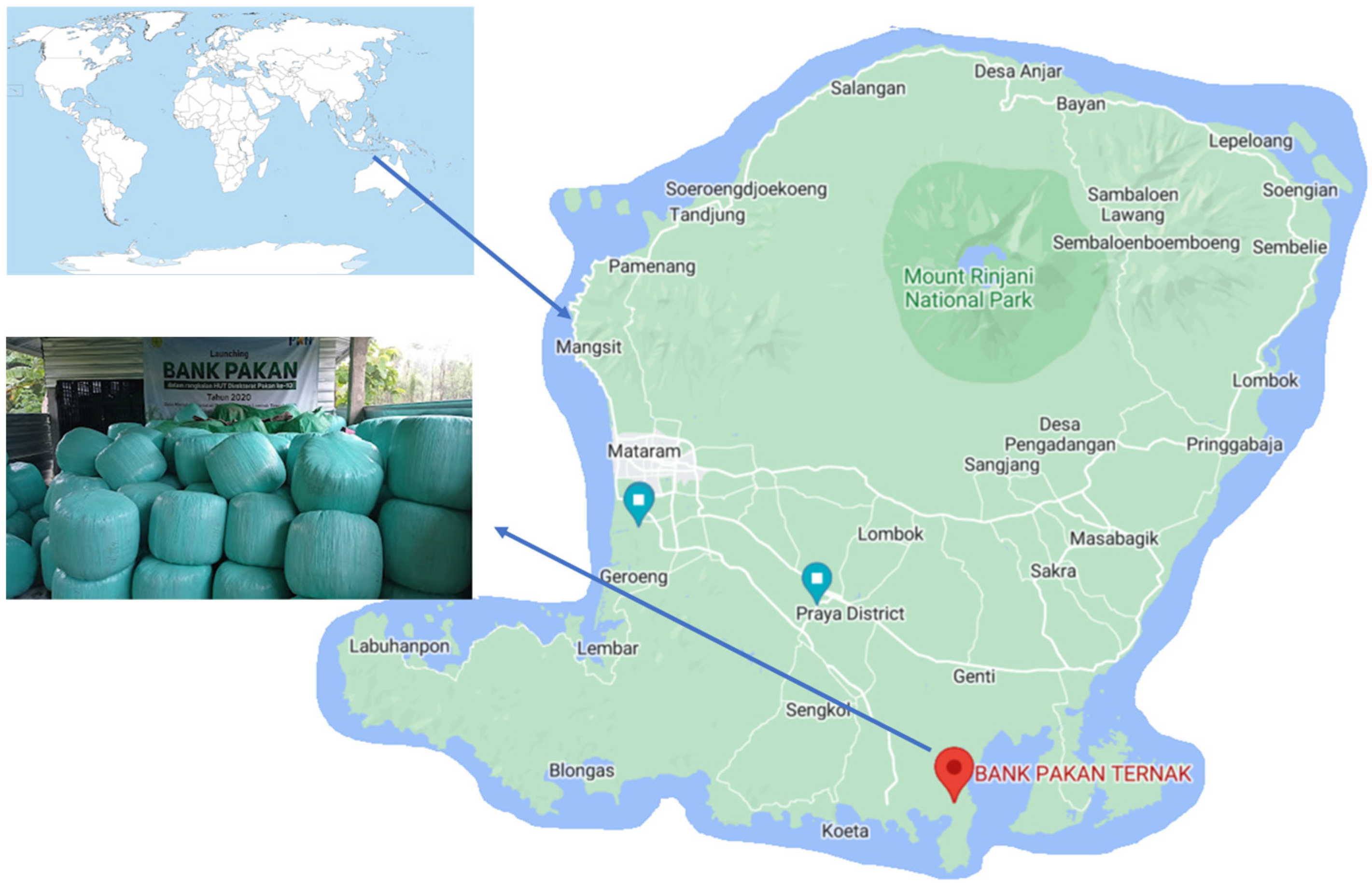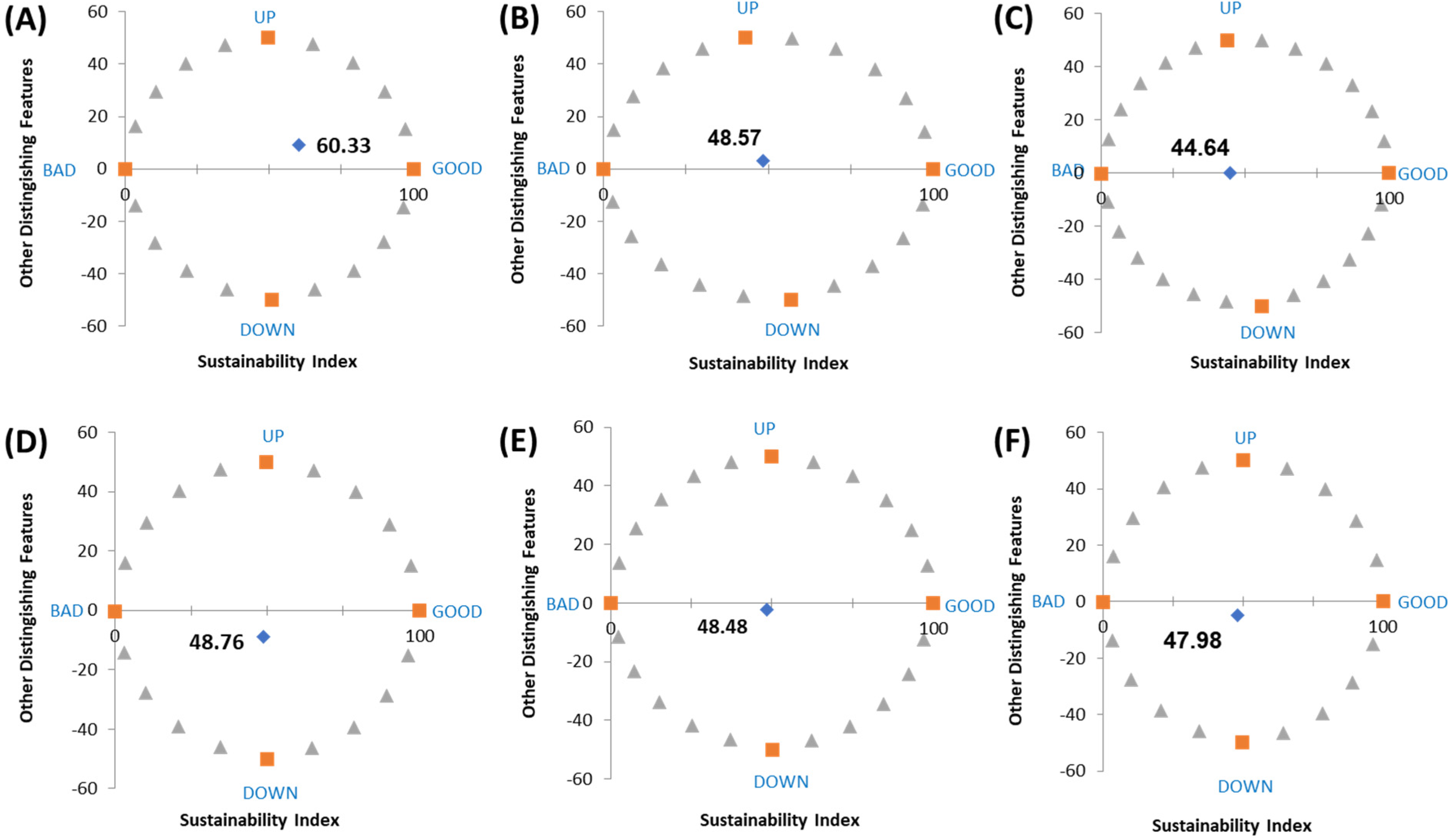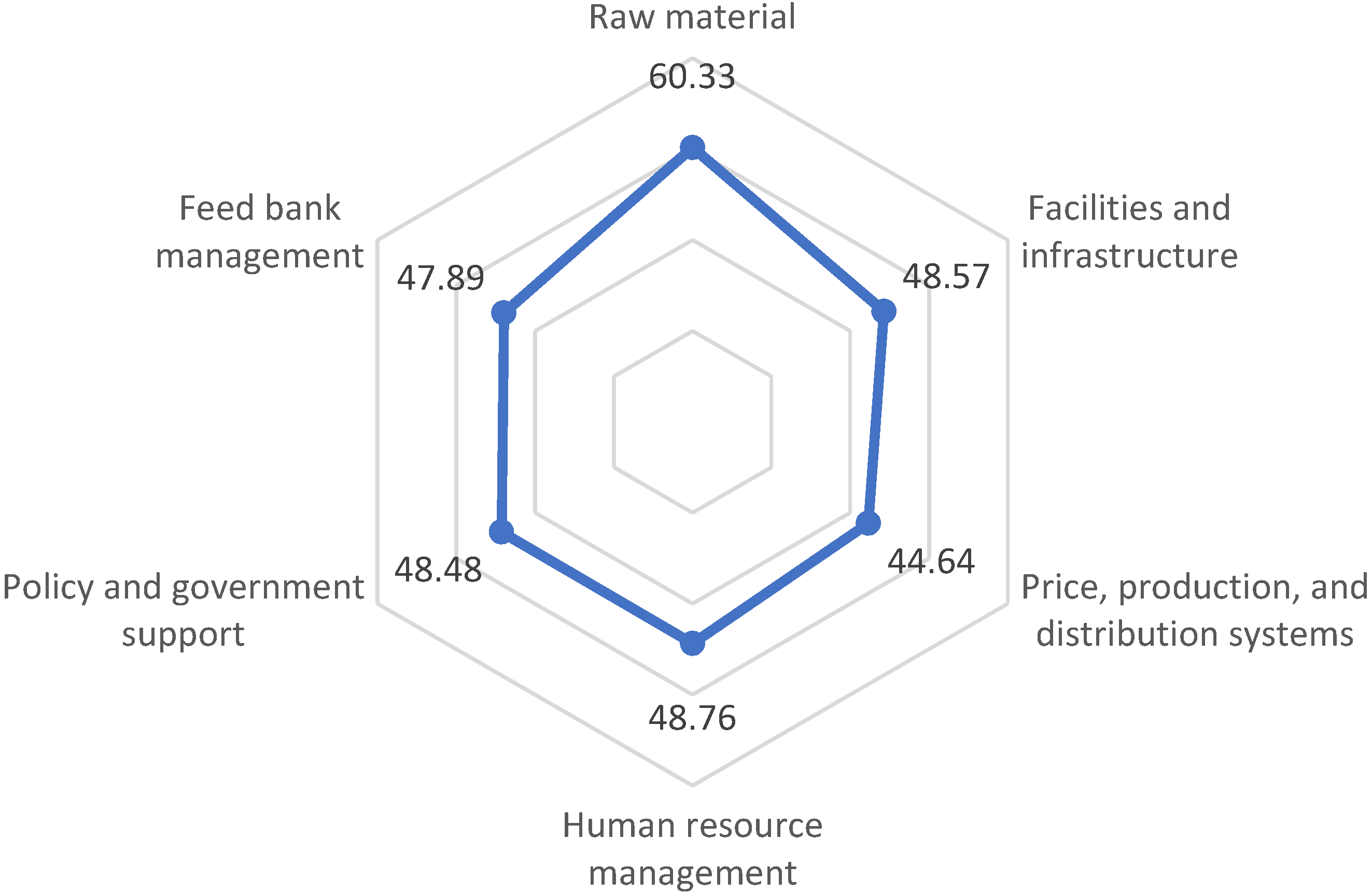The Sustainability and Development Strategy of a Cattle Feed Bank: A Case Study
Abstract
1. Introduction
2. Methodology
2.1. Sustainability Dimension and Attributes
2.2. Research Design
2.3. Data Collection and Attributes
3. Results and Discussion
3.1. Sustainability Index
3.2. Multi-Dimensional Stress Value and Coefficient of Determination (R2)
3.3. Multi-Dimensional Index of a Feed Bank Sustainability
3.4. Strategy for Feed Bank Development
3.4.1. Strengthening of Feed Bank Institutions
3.4.2. Improved Coaching and Mentoring
3.4.3. Training for the Feed Bank Managers
3.4.4. Developing the Feed Bank Partnership
3.4.5. Enhancing Multi-Stakeholder Roles
4. Conclusions
Author Contributions
Funding
Institutional Review Board Statement
Informed Consent Statement
Data Availability Statement
Conflicts of Interest
References
- Hati, S.R.H.; Zulianti, I.; Achyar, A.; Safira, A. Perceptions of Nutritional Value, Sensory Appeal, and Price Influencing Customer Intention to Purchase Frozen Beef: Evidence from Indonesia. Meat Sci. 2021, 172, 108306. [Google Scholar] [CrossRef] [PubMed]
- Available online: https://www.mla.com.au/globalassets/mla-corporate/prices--markets/documents/os-markets/red-meat-market-snapshots/2020/2020-indonesia-market-snapshot.pdf (accessed on 1 April 2022).
- Permani, R. Determinants of Relative Demand for Imported Beef and a Review of Livestock Self-Sufficiency in Indonesia. J. Southeast Asian Econ. 2013, 30, 294–308. [Google Scholar] [CrossRef]
- Priyanti, A.; Hanifah, V.W.; Mahendri, I.G.A.P.; Cahyadi, F.; Cramb, R.A.; Priyanti, A.; Hanifah, V.W.; Mahendri, I.G.A.P.; Cahyadi, F.; Cramb, R.A. Small-Scale Beef Cattle Production in East Java, Indonesia. In Proceedings of the Australian Agricultural and Resource Economics Society (AARES), Fremantle, Australia, 7–10 February 2012. [Google Scholar] [CrossRef]
- Dahlanuddin; Henderson, B.; Dizyee, K.; Hermansyah; Ash, A. Assessing the Sustainable Development and Intensification Potential of Beef Cattle Production in Sumbawa, Indonesia, Using a System Dynamics Approach. PLoS ONE 2017, 12, e0183365. [Google Scholar] [CrossRef]
- Agus, A.; Mastuti Widi, T.S. Current Situation and Future Prospects for Beef Cattle Production in Indonesia—A Review. Asian-Australas. J. Anim. Sci. 2018, 31, 976–983. [Google Scholar] [CrossRef]
- Burrow, H. Strategies for Increasing Beef Cattle Production under Dryland Farming Systems. Indones. Bull. Anim. Vet. Sci. 2019, 29, 161. [Google Scholar] [CrossRef]
- Alary, V.; Messad, S.; Aboul-Naga, A.; Osman, M.A.; Abdelsabour, T.H.; Salah, A.-A.E.; Juanes, X. Multi-Criteria Assessment of the Sustainability of Farming Systems in the Reclaimed Desert Lands of Egypt. Agric. Syst. 2020, 183, 102863. [Google Scholar] [CrossRef]
- Mutyasira, V.; Hoag, D.; Pendell, D.; Manning, D.T.; Berhe, M. Assessing the Relative Sustainability of Smallholder Farming Systems in Ethiopian Highlands. Agric. Syst. 2018, 167, 83–91. [Google Scholar] [CrossRef]
- Mosnier, C.; Benoit, M.; Minviel, J.J.; Veysset, P. Does Mixing Livestock Farming Enterprises Improve Farm and Product Sustainability? Int. J. Agric. Sustain. 2022, 20, 312–326. [Google Scholar] [CrossRef]
- Migliorini, P.; Galioto, F.; Chiorri, M.; Vazzana, C. An Integrated Sustainability Score Based on Agro-Ecological and Socioeconomic Indicators. A Case Study of Stockless Organic Farming in Italy. Agroecol. Sustain. Food Syst. 2018, 42, 859–884. [Google Scholar] [CrossRef]
- Lynch, J.; Donnellan, T.; Finn, J.A.; Dillon, E.; Ryan, M. Potential Development of Irish Agricultural Sustainability Indicators for Current and Future Policy Evaluation Needs. J. Environ. Manag. 2019, 230, 434–445. [Google Scholar] [CrossRef]
- Mashur, M.; Kholik, K.; Munawaroh, M.; Sriasih, M.; Oktaviana, D.; Sadiyah, S.N. Sustainability Analysis of Beef Cattle and Development Strategy Based on Collective Cages in Lombok Island. In International Virtual Seminar on Livestock Production and Veterinary Technology; IAARD Press: Jakarta, Indonesia, 2021; Volume 1, pp. 383–393. [Google Scholar]
- BPS Pujut Sub-District in Figures. Available online: https://lomboktengahkab.bps.go.id/publication/2016/07/29/7184e74680f0f82fdea84013/kecamatan-pujut-dalam-angka-2016.html (accessed on 30 May 2022).
- Kavanagh, P.; Pitcher, T.J. Implementing Microsoft Excel Software for Rapfish: A Technique for the Rapid Appraisal of Fisheries Status; University of British Columbia: Vancouver, BC, Canada, 2004. [Google Scholar] [CrossRef]
- Pitcher, T.J.; Preikshot, D. Rapfish: A Rapid Appraisal Technique to Evaluate the Sustainability Status of Fisheries. Fish. Res. 2001, 49, 255–270. [Google Scholar] [CrossRef]
- Jebb, A.T.; Ng, V.; Tay, L. A Review of Key Likert Scale Development Advances: 1995–2019. Front. Psychol. 2021, 12, 637547. [Google Scholar] [CrossRef] [PubMed]
- Ponsiglione, A.M.; Amato, F.; Cozzolino, S.; Russo, G.; Romano, M.; Improta, G. A Hybrid Analytic Hierarchy Process and Likert Scale Approach for the Quality Assessment of Medical Education Programs. Mathematics 2022, 10, 1426. [Google Scholar] [CrossRef]
- Trendafilov, N.; Gallo, M. Metric Multidimensional Scaling (MDS) and Related Methods. In Multivariate Data Analysis on Matrix Manifolds; Springer Series in the Data Sciences; Springer International Publishing: Cham, Switzerland, 2021; pp. 325–371. ISBN 978-3-030-76973-4. [Google Scholar]
- Grünhage, G. Teil I: Visualisierung Der Auswirkungen Einer Sich Ändernden Distanzmetrik Auf Die Daten Mittels Kontinuierlichem MDS (CMDS); Teil II: Ableitung Des Latent Space Modells Für Netzwerkdaten Mittels Expectation-PropagationLow Dimensional Visualization and Modelling of Data Using Distance-Based Models: Part I: Visualization of the Effects of a Changing Distance on Data Using Continuous MDS (CMDS); Part II: Inference of the Latent Space Model for Network Data Using Expectation Propagation. Ph.D. Thesis, Technische Universität Berlin, Berlin, Germany, 2018. [Google Scholar] [CrossRef]
- Mashur, M.; Subagio, S.; Usman, K.; Hunaepi, H. Analysis of the Sustainability Status of Feed Banks in the 1000 Village Cow Program in Pujut District, Central Lombok: (Dimension of Availability, HR Management, and Production System, Price, Feed Distribution). Prism. Sains J. Pengkaj. Ilmu Dan Pembelajaran Mat. Dan IPA IKIP Mataram 2021, 9, 365. [Google Scholar] [CrossRef]
- Ramadhan, D.R.; Nindyantoro, N.; Suyitman, S. Status Keberlanjutan Wilayah Peternakan Sapi Potong Untuk Pengembangan Kawasan Agropolitan Di Kabupaten Bondowoso. J. Peternak. Indones. Indones. J. Anim. Sci. 2014, 16, 78. [Google Scholar] [CrossRef][Green Version]
- Suyitman, S.; Sutjahjo, S.H.; Djulardi, A. Status Keberlanjutan Wilayah Berbasis Peternakan Sapi Potong Terpadu Di Kabupaten Lima Puluh Kota–Sumatera Barat. J. Peternak. Indones. Indones. J. Anim. Sci. 2012, 14, 318. [Google Scholar] [CrossRef][Green Version]
- Nuryadin, R. Analisis Keberlanjutan Pengembangan Kawasan Pesisir Berbasis Rumput Laut Di Kabupaten Sumbawa Barat. Master’s Thesis, Bogor Agricultural University (IPB), Bogor, Indonesia, 2015. [Google Scholar]
- Karwacka, M.; Ciurzyńska, A.; Lenart, A.; Janowicz, M. Sustainable Development in the Agri-Food Sector in Terms of the Carbon Footprint: A Review. Sustainability 2020, 12, 6463. [Google Scholar] [CrossRef]
- Fauzi, A. Pemodelan Sumber Daya Perikanan; Gramedia Pustaka Utama: Jakarta, Indonesia, 2005; ISBN 978-979-22-1233-4. [Google Scholar]
- Roche, J.R.; Berry, D.P.; Delaby, L.; Dillon, P.G.; Horan, B.; Macdonald, K.A.; Neal, M. Review: New Considerations to Refine Breeding Objectives of Dairy Cows for Increasing Robustness and Sustainability of Grass-Based Milk Production Systems. Animal 2018, 12, s350–s362. [Google Scholar] [CrossRef]
- Renna, M.; Lussiana, C.; Malfatto, V.; Gerbelle, M.; Turille, G.; Medana, C.; Ghirardello, D.; Mimosi, A.; Cornale, P. Evaluating the Suitability of Hazelnut Skin as a Feed Ingredient in the Diet of Dairy Cows. Animals 2020, 10, 1653. [Google Scholar] [CrossRef]
- Münnich, M.; Khiaosa-ard, R.; Klevenhusen, F.; Hilpold, A.; Khol-Parisini, A.; Zebeli, Q. A Meta-Analysis of Feeding Sugar Beet Pulp in Dairy Cows: Effects on Feed Intake, Ruminal Fermentation, Performance, and Net Food Production. Anim. Feed Sci. Technol. 2017, 224, 78–89. [Google Scholar] [CrossRef]
- Mashur; Oktaviana, D.; Kholik; Unsunidhal. Implementation of Health Management of a Beef Cattle Feed on the Collective Cage Based Smallholder Farming in Lombok Island. AIP Conf. Proc. 2019, 2199, 050007. [Google Scholar]
- Asikin, Z.; Baker, D.; Villano, R.; Daryanto, A. Business Models and Innovation in the Indonesian Smallholder Beef Value Chain. Sustainability 2020, 12, 7020. [Google Scholar] [CrossRef]
- Opportunities and Challenges of Smallholders and Smallholding; Agriculture Issues and Policies; Horváth, D., Ed.; Nova Science Publishers: Hauppauge, NY, USA, 2021; ISBN 978-1-5361-9203-2. [Google Scholar]
- Devant, M.; Marti, S. Strategies for Feeding Unweaned Dairy Beef Cattle to Improve Their Health. Animals 2020, 10, 1908. [Google Scholar] [CrossRef] [PubMed]
- VandeHaar, M.J.; St-Pierre, N. Major Advances in Nutrition: Relevance to the Sustainability of the Dairy Industry. J. Dairy Sci. 2006, 89, 1280–1291. [Google Scholar] [CrossRef]




| Dimension | Code and the Attributes | RMS | Expert Evaluation |
|---|---|---|---|
| Raw material (A) | (A1) Planted/cultivated raw feed | * 3.69 | * 4 |
| (A2) Variability during the rainy season | * 3.05 | * 6 | |
| (A3) Reduced volume during the dry season | * 2.8 | * 5 | |
| (A4) Spoiled raw feed in the dry season | * 2.64 | 3 | |
| (A5) Knowledge of feed concentrate | * 2.55 | 2 | |
| (A6) Willingness to use feed concentrate | 2.29 | ||
| (A7) Availability during the rainy season | 2.15 | ||
| (A8) Self-support for concentrate feed use | 1.73 | ||
| (A9) Difficulty in feeding in the rainy season | 0.88 | ||
| (A10) Awareness of the benefits of concentrate feed | 0.06 | ||
| Facilities and infrastructure (B) | (B1) Machine operating costs | * 1.37 | * 6 |
| (B2) Rope availability for the next program | * 0.51 | 1 | |
| (B3) Availability of chopper and baller machines | * 0.49 | * 6 | |
| (B4) Cattle weighing scale | * 0.47 | * 4 | |
| (B4) Availability of wrapping sacks for the next program | * 0.4 | 1 | |
| (B5) Warehouse for equipment and machinery | 0.28 | ||
| (B6) Warehouse utilization | 0.24 | ||
| (B7) Warehouse for storing raw feed materials | 0.18 | ||
| (B8) Warehouse for the silage storage | 0.12 | ||
| (B9) Functional mechanical equipment | 0.06 | ||
| (B10) Access road to the feed bank | 0.05 | ||
| Price, production, and distribution systems (C) | (C1) Production planning | * 0.90 | * 4 |
| (C2) Production cost | * 0.89 | * 5 | |
| (C3) Product demand | * 0.78 | * 5 | |
| (C4) Product customer | * 0.68 | * 5 | |
| (C5) Raw material reserve | * 0.66 | * 4 | |
| (C6) Cost of raw material | * 0.57 | 2 | |
| (C7) Sales | * 0.55 | 2 | |
| (C8) Production interval | 0.47 | ||
| (C9) Working capital | 0.41 | ||
| (C10) Deficit of raw feed in the dry season | 0.23 | ||
| (C11) Purchase contract | 0.2 | ||
| (C12) Feed formulation | 0.19 | ||
| (C13) Concerns about lack of feed in the dry season | 0.14 | ||
| Human resource management (D) | (D1) Number of personal | * 2.25 | 2 |
| (D2) Skill in teamwork | * 1.93 | * 5 | |
| (D3) Skill in administration and finance | * 1.88 | * 5 | |
| (D4) Readiness to be the manager | * 1.88 | * 5 | |
| (D5) Business knowledge | * 1.73 | 3 | |
| (D6) Product trial | * 1.51 | * 5 | |
| (D7) Knowledge of feed technicality | 1.45 | ||
| (D8) Permanent mentor/assistant | 0.83 | ||
| (D9) Knowledge of the tasks | 0.48 | ||
| (D10) Knowledge of machinery | 0.16 | ||
| Policy and government support (E) | (E1) The role of the sub-district government | * 1.52 | 0 |
| (E2) Cooperation support for research institutes/universities | * 1.47 | * 7 | |
| (E3) Coaching frequency by the district officers | * 1.24 | ||
| (E4) Support from the business sector | * 1.20 | 3 | |
| (E5) Coaching frequency by the sub-district officers | * 0.85 | ||
| (E6) Coaching frequency by the village officers | 0.39 | * 4 | |
| (E8) Coaching frequency by the province officers | 0.37 | * 4 | |
| (E9) Financial support from the provincial government | 0.32 | ||
| (E10) Financial support from the central government | 0.23 | ||
| (E11) Roles of community leaders | 0.22 | ||
| (E12) Financial and support from the district government | 0.03 | ||
| (E13) Role of a village officer | 0.02 | ||
| Feed bank management (F) | (F1) Continues purchase of the product | * 1.71 | * 7 |
| (F2) Annual production plan | * 1.13 | 3 | |
| (F3) Decentralize feed bank | * 0.88 | * 4 | |
| (F4) Knowledge of tasks by managers | * 0.69 | * 5 | |
| (F5) Production capacity | * 0.65 | 2 | |
| (F6) Program on saving raw feed | * 0.61 | 1 | |
| (F7) Supply of raw feed from all farmer groups | 0.42 | ||
| (F8) Independent supply of raw feed | 0.28 | ||
| (F9) Awareness on the benefit of feed bank | 0.17 | ||
| (F10) Cooperation between farmer groups | 0.06 |
| Dimensions | Weightage (%) | Weightage Index |
|---|---|---|
| Policy and government support | 14.06 | 6.82 |
| Raw material | 15.63 | 9.43 |
| Facilities and infrastructure | 14.06 | 6.83 |
| Feed bank management | 17.19 | 8.23 |
| Human resource management | 19.53 | 9.52 |
| Price, production, and distribution systems | 19.53 | 8.72 |
| Total | 100 | 49.55 |
Publisher’s Note: MDPI stays neutral with regard to jurisdictional claims in published maps and institutional affiliations. |
© 2022 by the authors. Licensee MDPI, Basel, Switzerland. This article is an open access article distributed under the terms and conditions of the Creative Commons Attribution (CC BY) license (https://creativecommons.org/licenses/by/4.0/).
Share and Cite
Mashur, M.; Bilad, M.R.; Kholik, K.; Munawaroh, M.; Cheok, Q.; Huda, N.; Kobun, R. The Sustainability and Development Strategy of a Cattle Feed Bank: A Case Study. Sustainability 2022, 14, 7989. https://doi.org/10.3390/su14137989
Mashur M, Bilad MR, Kholik K, Munawaroh M, Cheok Q, Huda N, Kobun R. The Sustainability and Development Strategy of a Cattle Feed Bank: A Case Study. Sustainability. 2022; 14(13):7989. https://doi.org/10.3390/su14137989
Chicago/Turabian StyleMashur, Mashur, Muhammad Roil Bilad, Kholik Kholik, Muhammad Munawaroh, Quentin Cheok, Nurul Huda, and Rovina Kobun. 2022. "The Sustainability and Development Strategy of a Cattle Feed Bank: A Case Study" Sustainability 14, no. 13: 7989. https://doi.org/10.3390/su14137989
APA StyleMashur, M., Bilad, M. R., Kholik, K., Munawaroh, M., Cheok, Q., Huda, N., & Kobun, R. (2022). The Sustainability and Development Strategy of a Cattle Feed Bank: A Case Study. Sustainability, 14(13), 7989. https://doi.org/10.3390/su14137989










